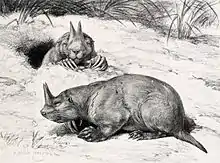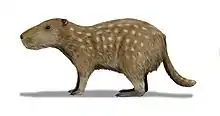List of extinct rodents
This list of extinct rodents lists the prehistoric rodents from the fossil record that are extinct−no longer extant.
The list may include extinct rodents of any period up to the ongoing Holocene −Anthropocene extinction event of the present Holocene epoch, that began approximately 11,700 years before present.
Fossils from related groups such as Lagomorpha (rabbits and hares) should not be included here.
Extinct prehistoric rodents
Prehistoric extinctions (beginning of the Holocene to 1500 AD)
| Genus | Species | Notes | Location | Approx. max. weight | Stratigraphy | Image |
|---|---|---|---|---|---|---|
| Castor | Castor californicus | An extinct beaver species | western North America | Late Miocene to Early Pleistocene[1] | ||
| Castoroides | giant beavers | North America | up to 100 kg (220 lb) | Pleistocene[2] |  | |
| Ceratogaulus | horned gophers | North America | (smallest horned mammal) | Late Miocene to Pliocene[3] |  | |
| Spelaeomys | S. florensis | a large cave rat | Flores | - | Extinct by 1500[4] | |
| "Giant hutias" | a paraphyletic group of rodents resembling large guinea pigs | West Indies | up to 200 kg (440 lb) | Pleistocene[5] | ||
| Leithia | a giant dormouse | Europe (Malta, Sicily) | 113 g (4.0 oz) | Pleistocene[6] | ||
| Neochoerus | N. pinckneyi | a large capybara | North America | 100 kg (220 lb) | Pleistocene[7] | |
| Josephoartigasia | J. monesi | 'giant pacarana', largest known rodent | South America | 1,500 kg (3,300 lb) | Pliocene to early Pleistocene[8] |  |
| Phoberomys | P. pattersoni | a horse-sized rodent[9] | North America | probably under 280 kg (620 lb);[9] earlier estimates up to 700 kg (1,500 lb)[10] | Miocene[9] | |
| Telicomys | a giant rodent, to 2 metres (6 ft 7 in) long | South American | perhaps 70% of size of P. pattersoni[9] | Late Miocene to early Pleistocene[9] |
Extinct Rodents
Recent extinctions (1500 to present)
See also
- Extinct rodents — all periods.
- Prehistoric rodents
- Rodent extinctions since 1500
References
- Harington, C. R. (March 1996). "Giant beaver". Yukon Beringia Interpretive Centre. Archived from the original on September 14, 2007. Retrieved 3 July 2014.
- Harington, C. R. (March 1996). "Giant beaver". Yukon Beringia Interpretive Centre. Archived from the original on September 14, 2007. Retrieved 3 July 2014.
- Hopkins, Samantha S. B. (2005). "The evolution of fossoriality and the adaptive role of horns in the Mylagaulidae (Mammalia: Rodentia)". Proceedings of the Royal Society B. 272 (1573): 1705–1713. doi:10.1098/rspb.2005.3171. PMC 1559849. PMID 16087426.
- Hooijer, D. A. (1957). "Three new giant prehistoric rats from Flores Lesser Sunda Islands". Zoologische Mededelingen. Rijksmuseum van Natuurlijke Historie, Leiden. 35 (21): 299–316.
- Biknevicius, A. R.; McFarlane, Donald A.; MacPhee, R. D. E. (1993). "Body size in Amblyrhiza inundata (Rodentia: Caviomorpha), an extinct megafaunal rodent from the Anguilla Bank, West Indies: estimates and implications" (PDF). American Museum Novitates (3079): 1–26.
- Petronio, C. (1970). "I roditori Pleistocenici della Grotta di Spinagallo (Siracusa)" (PDF). Geol. Rom. IX: 149–194. (in Italian)
- Kurtén, Björn; Anderson, Elaine (1980). Pleistocene Mammals of North America. Columbia University Press. p. 274. ISBN 0-231-03733-3.
- Rinderknecht, Andrés; Blanco, R. Ernesto (2008). "The largest fossil rodent" (PDF). Proceedings of the Royal Society B. 275 (1637): 923–928. doi:10.1098/rspb.2007.1645. PMC 2599941. PMID 18198140.
- Millien, Virginie; Bovy, Helene (2010). "When teeth and bones disagree: Body mass estimation of a giant extinct rodent". Journal of Mammalogy. 91 (1): 11–18. doi:10.1644/08-mamm-a-347r1.1. JSTOR 27755167.
- Sánchez-Villagra, M. R.; Aguilera, O.; Horovitz, I. (2003). "The anatomy of the world's largest rodent". Science. 301 (5640): 1708–10. doi:10.1126/science.1089332. PMID 14500978.
This article is issued from Wikipedia. The text is licensed under Creative Commons - Attribution - Sharealike. Additional terms may apply for the media files.